Shades of red
| Red | |
|---|---|
| Spectral coordinates | |
| Wavelength | ~630–740[1] nm |
| Frequency | ~480–405 THz |
| Common connotations | |
| heat, anger, passion, sexuality, love, socialism Christmas, Valentine's Day, danger | |
| Hex triplet | #FF0000 |
| Source | HTML/CSS[2] |
Varieties of the color red may differ in hue, chroma (also called saturation, intensity, or colorfulness) or lightness (or value, tone, or brightness), or in two or three of these qualities. Variations in value are also called tints and shades, a tint being a red or other hue mixed with white, a shade being mixed with black. A large selection of these various colors are shown below.
In specific color systems
Red (RGB)
| Red (RGB) | |
|---|---|
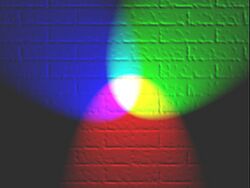 Red, green and blue lights, representing the three basic additive primary colors of the RGB color system, red, green, and blue | |
| Hex triplet | #FF0000 |
| Source | HTML/CSS[3] |
| ISCC–NBS descriptor | Vivid reddish orange |
Red (RGB), RGB red, or electric red[citation needed] (as opposed to pigment red, shown below) is the brightest possible red that can be reproduced on a computer monitor. This color is an approximation of an orangish red spectral color. It is one of the three primary colors of light in the RGB color model, along with green and blue. The three additive primaries in the RGB color system are the three colors of light chosen such as to provide the maximum gamut of colors that are capable of being represented on a computer or television set, at a reasonable expense of power. Portable devices such as mobile phones might have an even narrower gamut due to this purity–power tradeoff and their "red" may be less colorful and more orangish than the standard red of sRGB.
This color is also the color called red in the X11 web colors, which were originally formulated in 1987. It is also called color wheel red. It is at precisely zero (360) degrees on the HSV color wheel, also known as the RGB color wheel (Image of RGB color wheel). Its complementary color is cyan.
Red (CMYK) (pigment red)
| Red (CMYK) (pigment red) | |
|---|---|
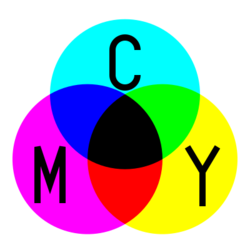 | |
| Hex triplet | #ED1B24 |
| Source | CMYK |
| ISCC–NBS descriptor | Vivid reddish orange |
Pigment red is the color red that is achieved by mixing process (printer's) magenta and process (printer's) yellow in equal proportions. This is the color red that is shown in the diagram located at the bottom of the following website offering tintbooks for CMYK printing: [1].
The purpose of the CMYK color system is to provide the maximum possible gamut of colors capable of being reproduced in printing.
Psychedelic art made people used to brighter colors of red, and pigment colors or colored pencils called "true red" are produced by mixing pigment red with a tiny amount of white. The result approximates (with much less brightness than is possible on a computer screen) the electric red shown above.
Red (Crayola)
| Red (Crayola) | |
|---|---|
| Hex triplet | #ED0A3F |
| Source | Crayola |
| ISCC–NBS descriptor | Vivid red |
The color is defined as red in Crayola crayons.
Red was one of the original colors formulated by Crayola in 1903.
Red (Munsell)
| Red (Munsell) | |
|---|---|
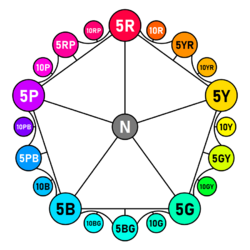 The hues of the Munsell color system, at varying values, and maximum chroma to stay in the sRGB gamut | |
| Hex triplet | #FF0042 |
| Source | https://pteromys.melonisland.net/munsell/ |
| ISCC–NBS descriptor | Vivid red |
The color is defined as red in the Munsell color system (Munsell 5R). The Munsell color system is a color space that specifies colors based on three color dimensions: hue, value (lightness), and chroma (color purity), spaced uniformly in three dimensions in the elongated oval at an angle shaped Munsell color solid according to the logarithmic scale which governs human perception. In order for all the colors to be spaced uniformly, it was found necessary to use a color wheel with five primary colors—red, yellow, green, blue, and purple.
The Munsell colors displayed are only approximate as they have been adjusted to fit into the sRGB gamut.
Red (NCS) (psychological primary red)
| Red (NCS) | |
|---|---|
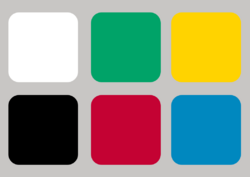 Approximations within the sRGB gamut to the primary colors of the Natural Color System, a model based on the opponent process theory of color vision | |
| Hex triplet | #C40234 |
| Source | sRGB approximation to NCS S 1080-R[4] |
| ISCC–NBS descriptor | Vivid red |
The color is defined as red in the NCS or Natural Color System (NCS 1080-R). The Natural Color System is a color system based on the four unique hues or psychological primary colors red, yellow, green, and blue. The NCS is based on the opponent process theory of vision.
The Natural Color System is widely used in Scandinavia.
Red (Pantone)
| Red (Pantone) | |
|---|---|
| Hex triplet | #ED2839 |
| Source | Pantone TPX[5] |
| ISCC–NBS descriptor | Vivid red |
The color is defined as red in Pantone.
The source of this color is the Pantone Textile Paper eXtended (TPX) color list, color No. 032M—Red.[6]
Variations of red
Madder
| Madder | |
|---|---|
| Hex triplet | #A50021 |
| Source | Internet |
| ISCC–NBS descriptor | Vivid red |
The color madder is named for a dye produced from plants of the genus Rubia.
Brink pink
| Brink pink | |
|---|---|
| Hex triplet | #FB607F |
| Source | Crayola |
| ISCC–NBS descriptor | Deep pink |
The color brink pink was formulated by Crayola in 1990.
Crimson
| Crimson | |
|---|---|
 | |
| Hex triplet | #DC143C |
| Source | X11 |
| ISCC–NBS descriptor | Vivid red |
Crimson is a strong, bright, deep red color combined with some blue or violet, resulting in a small degree of purple. It is also the color between rose and red on the RGB color wheel and magenta and red on the RYB color wheel.
rose
|
crimson
|
red
|
Pink
| Pink | |
|---|---|
| Hex triplet | #FFC0CB |
| Source | X11 color names[7] HTML/CSS[3] |
| ISCC–NBS descriptor | Strong pink |
The web color pink is a light tint of red, but is often considered to be a basic color term on its own.
Salmon pink
| Salmon Pink | |
|---|---|
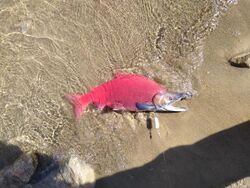 Male Kokanee Salmon | |
| Hex triplet | #FF91A4 |
| Source | Crayola |
| ISCC–NBS descriptor | Strong pink |
This color which represents the pinkish tone of salmon is called salmon in Crayola crayons. This color was introduced by Crayola in 1949. See the List of Crayola crayon colors.
Cardinal red
| Cardinal | |
|---|---|
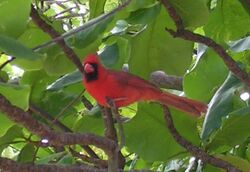 Cardinal bird in a tree | |
| Hex triplet | #C51E3A |
| Source | Maerz and Paul |
| ISCC–NBS descriptor | Vivid red |
Cardinal red, also called cardinal, is a vivid red, which gets its name from the cassocks worn by cardinals. The bird takes its name from the color.
Apple red
| Apple red | |
|---|---|
 A Red delicious | |
| Hex triplet | #BE0032 |
| Source | ISCC-NBS |
| ISCC–NBS descriptor | Vivid red |
Apple red is the color of the peel of an apple.
Poppy red
| Poppy red | |
|---|---|
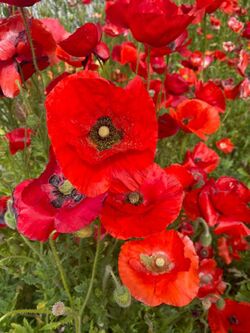 Poppy flower | |
| Hex triplet | #DC343B |
| Source | color-name.com |
| ISCC–NBS descriptor | Vivid red |
The color poppy red is named after the poppy flower.
Poppy red is a shade of pink-red.[8] Lieutenant-Colonel John McCrae, a Canadian officer and surgeon in World War I, wrote possibly history's most famous wartime poem, called "In Flanders Fields", written in 1915.[9] It helped the poppy (Papaver rhoeas) become a symbol of remembrance for soldiers who have died during the conflict and later conflicts.[10]
Carmine
| Carmine | |
|---|---|
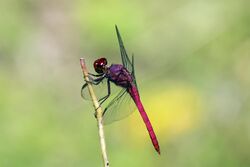 Carmine skimmer (male) | |
| Hex triplet | #960018 |
| Source | Pourpre.com |
| ISCC–NBS descriptor | Vivid red |
The color carmine is a vivid crimson. In its pigment form it mostly contains the red light with wavelengths longer than 600 nm, i.e. it is close to the extreme spectral red. This places it far beyond standard gamuts (both RGB and CMYK), and its given RGB value is a poor approximation only.
Spanish red
| Spanish red | |
|---|---|
| Hex triplet | #E60026 |
| Source | Gallego and Sanz[11][12] |
| ISCC–NBS descriptor | Vivid reddish orange |
Spanish red, an iron oxide red[13] also known as torch red, is the color that is called rojo (the Spanish word for "red") in the Guía de coloraciones (Guide to colorations) by Rosa Gallego and Juan Carlos Sanz, a color dictionary published in 2005 that is widely popular in the Hispanophone realm.
Rusty red
| Rusty red | |
|---|---|
| Hex triplet | #DA2C43 |
| Source | Crayola |
| ISCC–NBS descriptor | Vivid red |
Rusty red is a color formulated by Crayola in 1990 as one of the colors in its Silver Swirls specialty crayon box of metallic colors.
Chocolate cosmos
| Chocolate Cosmos | |
|---|---|
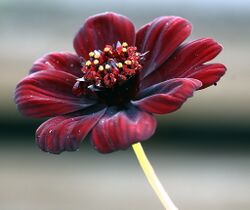 Chocolate cosmos flower | |
| Hex triplet | #58111A |
| Source | [Unsourced] |
| ISCC–NBS descriptor | Deep reddish brown |
Chocolate cosmos, or red cosmos is the color of Cosmos atrosanguineus species.[14]
The color is described as dark red, deep crimson, deeper burgundy, deep red chocolate, as dark hazelnut and velvety maroon.[citation needed]
Rosewood
| Rosewood | |
|---|---|
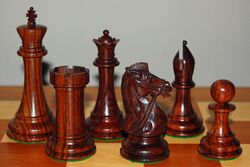 Rosewood chess pieces | |
| Hex triplet | #65000B |
| Source | ColorHexa |
| ISCC–NBS descriptor | Deep reddish brown |
The color rosewood is named after rosewood.
The first recorded use of rosewood as a color name in English was in 1892.[15] Actual rosewood exhibits a wide range of colors.[16]
Imperial red
| Imperial Red | |
|---|---|
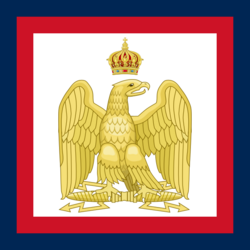 Imperial standard of Napoleon I | |
| Hex triplet | #ED2939 |
| Source | Vexillological[17] |
| ISCC–NBS descriptor | Vivid red |
Imperial red is a representation of the red color of the Imperial Standard of Napoleon I.
The first recorded use of imperial red as a color name in English was in 1914.[18] Note: the RGB values for Pantone red and imperial red are identical.
Cordovan
| Cordovan | |
|---|---|
| Hex triplet | #893F45 |
| Source | Pantone Color Planner[19] |
| ISCC–NBS descriptor | Dark red |
Cordovan is a rich medium dark shade of red.
The first recorded use of cordovan as a color name in English was in 1925.[20]
Fire engine red
| Fire engine red | |
|---|---|
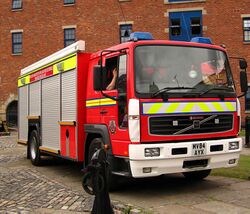 A fire engine of the Greater Manchester Fire and Rescue Service. | |
| Hex triplet | #CE2029 |
| Source | [21] |
| ISCC–NBS descriptor | Vivid red |
Fire engine red is an intense, bright red commonly used on emergency vehicles; mostly on fire engines, other associated fire service vehicles, and ambulances.
Rose vale
| Rose vale | |
|---|---|
| Hex triplet | #AB4E52 |
| Source | ISCC-NBS |
| ISCC–NBS descriptor | Moderate red |
The first recorded use of rose vale as a color name in English was in 1923.[22]
Old rose
| Old rose | |
|---|---|
| Hex triplet | #C08081 |
| Source | ISCC-NBS |
| ISCC–NBS descriptor | Dark pink |
The color old rose, also known as ashes of rose, was a popular Victorian color. The first recorded use of old rose as a color name in English was in 1892.[23]
Bittersweet shimmer
| Bittersweet shimmer | |
|---|---|
| Hex triplet | #BF4F51 |
| Source | Crayola |
| ISCC–NBS descriptor | Moderate red |
Bittersweet shimmer is one of the colors in the special set of metallic Crayola crayons called Metallic FX, the colors of which were formulated by Crayola in 2001.
Although this is supposed to be a metallic color, there is no mechanism for displaying metallic colors on a computer.
Light red
| Light red | |
|---|---|
| Hex triplet | #FF7F7F |
| Source | X11 color names[7] HTML/CSS[3] |
| ISCC–NBS descriptor | Vivid yellowish pink |
The color light red, though very similar to pink, is a shade of red that is roughly 50% lighter than red.
Light coral
| Light coral | |
|---|---|
| Hex triplet | #F08080 |
| Source | HTML/CSS[3] X11 color names[7] |
| ISCC–NBS descriptor | Deep pink |
The web color light coral is a pinkish-light orange color. It is also a HTML/CSS color name and a X11 color name.
Garnet
| Garnet | |
|---|---|
 Garnet jewelry | |
| Hex triplet | #733635 |
| Source | Encycolorpedia[24] |
| ISCC–NBS descriptor | Deep reddish brown |
The color garnet can be considered a dark tone of red, with some slight purple tints.
This color represents the hue of an average garnet gemstone, though garnets can range in color from orange to (very rarely) green.
Rose ebony
| Rose ebony | |
|---|---|
| Hex triplet | #674846 |
| Source | ISCC-NBS |
| ISCC–NBS descriptor | Grayish reddish brown |
The first recorded use of rose ebony as a color name in English was in 1924.[25]
Chili red
| Chili red | |
|---|---|
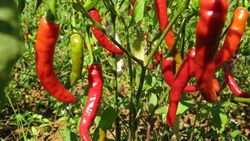 Burmese chili pepper | |
| Hex triplet | #E03C31 |
| Source | National Flag |
| ISCC–NBS descriptor | Vivid reddish orange |
Chili red is the color of red chili peppers. It is the shade of red used in the flags of Chile and South Africa. On the flag of South Africa, it is defined as Pantone 179. [2]
Vermilion
| Vermilion | |
|---|---|
 Chinese carved cinnabar lacquerware | |
| Hex triplet | #E34234 |
| Source | Maerz and Paul[26] |
| ISCC–NBS descriptor | Vivid reddish orange |
Vermilion (sometimes spelled vermillion) is both a brilliant red or scarlet pigment, originally made from the powdered mineral cinnabar (). It was widely used in the art and decoration of Ancient Rome, in the illuminated manuscripts of the Middle Ages, in the paintings of the Renaissance, as sindoor, an Indian cosmetic powder, and in the art and lacquerware of China.
Misty rose
| Misty rose | |
|---|---|
| Hex triplet | #FFE4E1 |
| Source | X11 |
| ISCC–NBS descriptor | Pale yellowish pink |
The web color misty rose is written as mistyrose in HTML code for computer display.[27]
The color name misty rose first came into use in 1987, when this color was formulated as one of the X11 colors, which in the early 1990s became known as the X11 web colors.
Turkey red
| Turkey red | |
|---|---|
| Hex triplet | #A91101 |
| Source | [Unsourced] |
| ISCC–NBS descriptor | Strong reddish brown |
Turkey red is a color that was widely used to dye cotton in the 18th and 19th centuries. It was made using the root of the Rubia plant, through a long and laborious process. It originated in India or Turkey, and was brought to Europe in the 1740s. In France, it was known as rouge d'Andrinople.[28]
Salmon
| Salmon | |
|---|---|
 Sockeye male salmon | |
| Hex triplet | #FA8072 |
| Source | X11 |
| ISCC–NBS descriptor | Strong reddish orange |
The web color salmon represents the color of the flesh of an average salmon. However, actual salmon flesh can range in hue from a light pinkish-orange to a bright red (as is the case with sockeye salmon).
Coral pink
| Coral Pink | |
|---|---|
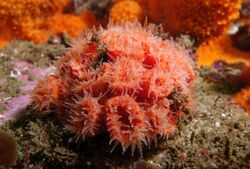 | |
| Hex triplet | #F88379 |
| Source | ISCC-NBS[29] |
| ISCC–NBS descriptor | Deep yellowish red |
The color coral pink is a pinkish color.[29]
The first recorded use of coral pink as a color name in English was in 1892.[30] Late in 2016, the color sample was renamed Coral Red by Pantone, as the RGB, Hex and HTML color table showed the same color as being reddish, standing against popular belief of pinkish.
Still today, some people call Coral Red as Coral Pink due to this old attribution.
The complementary color of coral pink is teal[citation needed].
Cantaloupe Melon
| Cantaloupe Melon | |
|---|---|
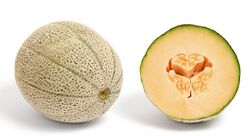 A cantaloupe from Australia. | |
| Hex triplet | #FDBCB4 |
| Source | Crayola |
| ISCC–NBS descriptor | Moderate yellowish pink |
The color cantaloupe melon is a representation of the color of the interior flesh of a cantaloupe, the most commonly consumed melon.
The first recorded use of melon as a color name in English was in 1892.[31]
In 1958, melon was formulated as one of the Crayola colors.
Barn red
| Barn Red | |
|---|---|
 A barn in Oregon, USA | |
| Hex triplet | #7C0902 |
| Source | Milk Paint |
| ISCC–NBS descriptor | Deep reddish brown |
The color barn red is one of the colors on one of the milk paint color lists, paint colors formulated to reproduce the colors historically used on the American frontier and made, like those paints were, with milk. This color is mixed with various amounts of white paint to create any desired shade of the color barn red.[32]
Blood red
| Blood red | |
|---|---|
 | |
| Hex triplet | #660000 |
| Source | Thom Poole's 2017 book Life of Colour[33]:80 |
| ISCC–NBS descriptor | Deep reddish brown |
The color of blood red ranges from crimson to a dark brown-red and may have a slightly orange hue. In the RGB color spectrum, it often consists only of the color red, with no green or blue component; in the CMYK color model blood red has no cyan, and consists only of magenta and yellow with a small amount of black. It is frequently darker than both maroon and dark red.
In China, according to The Language of Color in China,[34] dark blood red is sometimes referred to as "period (i.e., menstruation) red".
Tea rose
| Tea rose | |
|---|---|
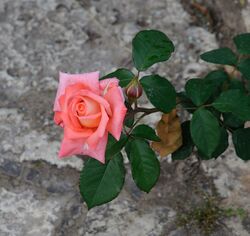 Tea rose colour | |
| Hex triplet | #F4C2C2 |
| Source | ISCC-NBS |
| ISCC–NBS descriptor | Moderate yellowish pink |
The color tea rose is the tint of the color that is used in interior design. This color is popular in interior design for painting bedrooms, especially among women.[citation needed]
There is a different color sometimes called tea rose, which is the color of an orange rose called a tea rose.[35] This other color is technically Congo pink.
The first recorded use of tea rose as a color name in English was in 1884.[36]
Cinnabar
| Cinnabar | |
|---|---|
 | |
| Hex triplet | #E44D2E |
| Source | Thom Poole's 2017 book Life of Colour[33][self-published source?] |
| ISCC–NBS descriptor | Vivid reddish orange |
The color cinnabar derives from the mineral of the same name. It is a slightly orange shade of red, with variations ranging from bright scarlet to brick red.
Dark red
| Dark red | |
|---|---|
| Hex triplet | #8B0000 |
| Source | X11 |
| ISCC–NBS descriptor | Strong reddish brown |
This is the web color dark red.
Fire brick
| Fire brick | |
|---|---|
| Hex triplet | #B22222 |
| Source | X11 |
| ISCC–NBS descriptor | Vivid red |
This is the web color fire brick.
Indian red
| Indian Red | |
|---|---|
| Hex triplet | #CD5C5C |
| Source | X11 |
| ISCC–NBS descriptor | Moderate red |
The name Indian red derives from the red laterite soil found in India, which is composed of naturally occurring iron oxides. The first recorded use of "Indian red" as a color term in English was in 1792.[37]
Lust
| Lust | |
|---|---|
| Hex triplet | #E62020 |
| Source | ISCC-NBS |
| ISCC–NBS descriptor | Vivid reddish orange |
Lust is a rich shade of red.
This color is not mentioned in the 1930 book A Dictionary of Color by Maerz and Paul but is found on the 1955 ISCC-NBS color list.
Maroon (HTML/CSS)
| Maroon | |
|---|---|
| Hex triplet | #800000 |
| Source | HTML/CSS[3] |
| ISCC–NBS descriptor | Deep reddish brown |
This is the web color called maroon in HTML/CSS. It only consists of red in RGB and no cyan in CMYK.
Redwood
| Redwood | |
|---|---|
 A redwood tree | |
| Hex triplet | #A45953 |
| Source | Pantone TPX[38] |
| ISCC–NBS descriptor | Dark reddish orange |
The color redwood is a representation of color of the wood of the redwood tree (Sequoia sempervirens).
The first recorded use of redwood as a color name in English was in 1917.[39]
The source of this color is the Pantone Textile Paper eXtended (TPX) color list, color #18-1443—Redwood.[6]
Scarlet
| Scarlet | |
|---|---|
 | |
| Hex triplet | #FF2400 |
| Source | [Unsourced] |
| ISCC–NBS descriptor | Vivid reddish orange |
Scarlet is a bright red with a slightly orange tinge. According to surveys in Europe and the United States, scarlet and other bright shades of red are the colors most associated with courage, force, passion, heat, and joy.[40] In the Roman Catholic Church, scarlet is the color worn by cardinals, and is associated with the blood of Christ and the Christian martyrs, and with sacrifice.
Tomato
| Tomato | |
|---|---|
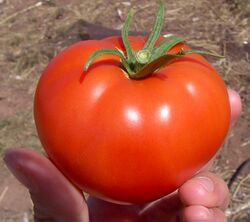 A typical tomato | |
| Hex triplet | #FF6347 |
| Source | X11 |
| ISCC–NBS descriptor | Vivid reddish orange |
The web color tomato is a medium reddish-orange color that approximates the color of common supermarket tomatoes. Many vine-ripened tomatoes are a bit redder. The color of tomato soup is slightly less saturated.
The first recorded use of tomato as a color name in English was in 1891.[41]
When the X11 color names were invented in 1987, the color tomato was formulated as one of them.
Jasper
| Jasper | |
|---|---|
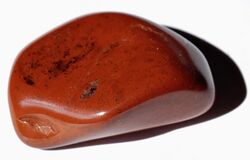 Polished red jasper | |
| Hex triplet | #D05340 |
| Source | Crayola |
| ISCC–NBS descriptor | Strong reddish orange |
The color jasper is named for red jasper, the most commonly known form of jasper; however, as with many gemstones, jasper can be found in many colors, from yellow to brown and even green. The color was formulated by Crayola in 1994 as part of their Gem Tones crayon set.
Rosy brown
| Rosy brown | |
|---|---|
| Hex triplet | #BC8F8F |
| Source | X11 |
| ISCC–NBS descriptor | Light grayish red |
The name for the web color rosy brown first came into use in 1987, when this color was formulated as one of the X11 colors, which in the early 1990s became known as the X11 web colors.
Rose taupe
| Rose taupe | |
|---|---|
| Hex triplet | #905D5D |
| Source | ISCC-NBS |
| ISCC–NBS descriptor | Grayish red |
The first recorded use of rose taupe as a color name in English was in 1924.[42]
Amaranth
| Amaranth | |
|---|---|
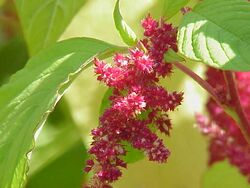 The flower of the amaranth plant | |
| Hex triplet | #E52B50 |
| Source | ColorHexa[43] |
Amaranth is a pinkish-red color, which gets its name from the color of a red amaranth flower.
Fluorescent red
| Fluorescent red | |
|---|---|
| Hex triplet | #FF2226 |
| Source | [3] |
| ISCC–NBS descriptor | Vivid reddish orange |
Fluorescent red is a light brilliant red color.
See also
- Lists of colors
- Iron oxide red
- Ruby (color)
References
- ↑ Thomas J. Bruno, Paris D. N. Svoronos. CRC Handbook of Fundamental Spectroscopic Correlation Charts. CRC Press, 2005.
Color - ↑ "CSS Color Module Level 3". http://www.w3.org/TR/css3-color/#html4.
- ↑ 3.0 3.1 3.2 3.3 3.4 W3C TR CSS3 Color Module, HTML4 color keywords. W3C. (May 2003). Retrieved on 16 September 2008.
- ↑ The sRGB values are taken by converting the NCS color 1080-R using the "NCS Navigator" tool at the NCS website.
- ↑ Type the word "Red" into the indicated window on the Pantone Color Finder and the color will appear.
- ↑ 6.0 6.1 "Search – Find a PANTONE Color". http://www.pantone.com/pages/pantone/colorfinder.aspx.
- ↑ 7.0 7.1 7.2 X11 rgb.txt . XFree86. (February 1994). Retrieved on 16 September 2008.
- ↑ "Pantone / PMS 17-1664 TCX / Poppy Red / #dc343b Hex Color Code". encycolorpedia.com. https://encycolorpedia.com/dc343b.
- ↑ "In Flanders Fields". Encyclopædia Britannica. https://www.britannica.com/topic/In-Flanders-Fields.
- ↑ "Why the Poppy?". BBC. https://www.bbc.co.uk/remembrance/how/poppy.shtml#:~:text=The%20poppy%20came%20to%20represent,War%20One%20and%20later%20conflicts.
- ↑ Gallego, Rosa; Sanz, Juan Carlos (2005). Guía de coloraciones (Gallego, Rosa; Sanz, Juan Carlos (2005). Guide to Colorations) Madrid: H. Blume. ISBN:84-89840-31-8
- ↑ Gallego, Rose and Sanz, Juan Carlos "Diccionario Akal del color" (2001) Akal ISBN:978-84-460-1083-8
- ↑ Gettens & Stout 1966.
- ↑ Amamiya, K., & Iwashina, T. (2016). Qualitative and Quantitative Analysis of Flower Pigments in Chocolate Cosmos, Cosmos atrosanguineus, and its Hybrids. Natural Product Communications, 11(1), 77–78.
- ↑ Maerz and Paul A Dictionary of Color New York:1930 McGraw-Hill Page 203; Color Sample of rosewood Page 33 Plate 5 Color Sample J9
- ↑ "About the classical guitar". Mangore.com. http://www.mangore.com/about_the_classical_guitar.html.
- ↑ The color displayed in the color box above matches the color called imperial red in the 1930 book by Maerz and Paul A Dictionary of Color New York:1930 McGraw-Hill; the color imperial red is displayed on page 27, Plate 2, Color Sample L11.
- ↑ Maerz and Paul A Dictionary of Color New York:1930 McGraw-Hill Page 196; Color Sample of Imperial Red: Page 27 Plate 2 Color Sample L11
- ↑ Shah, David. "Pantone View Color Planner Summer 2007 Key Color Combinations". Metropolitan Publishing of Amsterdam. http://www.retailinsights.be/uploadedfiles/eiseman%20key%20color%20combos.pdf.
- ↑ Maerz and Paul A Dictionary of Color New York:1930 McGraw-Hill Page 193; Color Sample of Cordovan Page 39 Plate 8 Color Sample H8
- ↑ "Fire Engine Red". FindTheBest.com. http://colors.findthedata.org/l/727/Fire-Engine-Red.
- ↑ Maerz and Paul A Dictionary of Color New York:1930 McGraw-Hill Page 203; Color sample of rose vale p. 33 Plate 5 Color Sample K9
- ↑ Maerz and Paul A Dictionary of Color New York:1930 McGraw-Hill Page 200 Color Sample: Page 31 Plate 4 Color Sample I2
- ↑ "Garnet/#733635 Hex Color Code". http://encycolorpedia.com/733635.
- ↑ Maerz and Paul A Dictionary of Color New York:1930 McGraw-Hill Page 203; Color Sample of rose Ebony Page 39 Plate 8 Color Sample E6
- ↑ The color displayed in the color box above matches the color called vermilion in the 1930 book by Maerz and Paul A Dictionary of Color New York:1930 McGraw-Hill; the color vermilion is displayed on page 27, Plate 2, Color Sample L11. It is noted on page 193 that the color cinnabar is another name for the color vermilion.
- ↑ CSS3 Color Module. Retrieved 15 February 2007.
- ↑ Lowengard, Sarah (2006). The Creation of Color in Eighteenth-Century Europe. Columbia University Press. http://www.gutenberg-e.org/lowengard.
- ↑ 29.0 29.1 "Ca through Cz". ISCC-NBS Dictionary of Colo(u)r Names. John C. Foster and Texas Precancel Club. 1955. color sample #26. http://tx4.us/nbs/nbs-c.htm. The ISCC-NBS Dictionary of Color Names is a color dictionary used by stamp collectors to identify the colors of stamps.
- ↑ Maerz, Aloys John; Paul, Morris Rea (1930). A Dictionary of Color. New York: McGraw-Hill Book Company. p. 193.; color sample of coral pink: page 27, plate 2, color sample F9.
- ↑ Maerz and Paul A Dictionary of Color New York:1930 McGraw-Hill Page 199; Color Sample of Melon: Page 27 Plate 2 Color Sample D10
- ↑ "Color Palette & Tinting Chart". http://www.milkpaint.com/color.html.
- ↑ 33.0 33.1 Thom Poole (2017). Life of Colour. Lulu.com. p. 81. ISBN 978-1-326-65724-6. https://books.google.com/books?id=uu-rDgAAQBAJ&pg=PA80.[self-published source]
- ↑ Zhou, Jun (2018). The language of color in China. Taylor, Gail. Newcastle upon Tyne. ISBN 978-1527511224. OCLC 1035512873.
- ↑ Maerz and Paul A Dictionary of Color New York:1930 – McGraw-Hill – Discussion of color tea rose, Page 183
- ↑ Maerz and Paul A Dictionary of Color New York:1930 McGraw-Hill Page 183
- ↑ Mish, Frederic C., Editor in Chief Webster's Tenth New Collegiate Dictionary Springfield, Massachusetts, U.S.A.:1994 – Merriam-Webster Page 592
- ↑ Type the word "Redwood" into the indicated window on the Pantone Color Finder and the color will appear.
- ↑ Maerz and Paul A Dictionary of Color New York:1930 McGraw-Hill Page 203; Color Sample of Redwood: Page 35 Plate 6 Color Sample K11
- ↑ Eva Heller (2009), Psychologie de la couleur; effets et symboliques, pp. 42–49
- ↑ Maerz and Paul A Dictionary of Color New York:1930 McGraw-Hill Page 205; Color Sample of Tomato: Page 29 Plate 3 Color Sample I12
- ↑ Maerz and Paul A Dictionary of Color New York:1930 McGraw-Hill Page 203; Color Sample of rose Taupe Page 55 Plate 16 Color Sample A4
- ↑ "Amaranth / #e52b50 hex color" (in en). https://www.colorhexa.com/e52b50.
Sources
- Gettens, R. J.; Stout, G. L. (1966). "Iron Oxide Red". Painting Materials: A Short Encyclopedia. Courier Corporation. p. 122. ISBN 978-0-486-14242-5. OCLC 868969354.
 |


